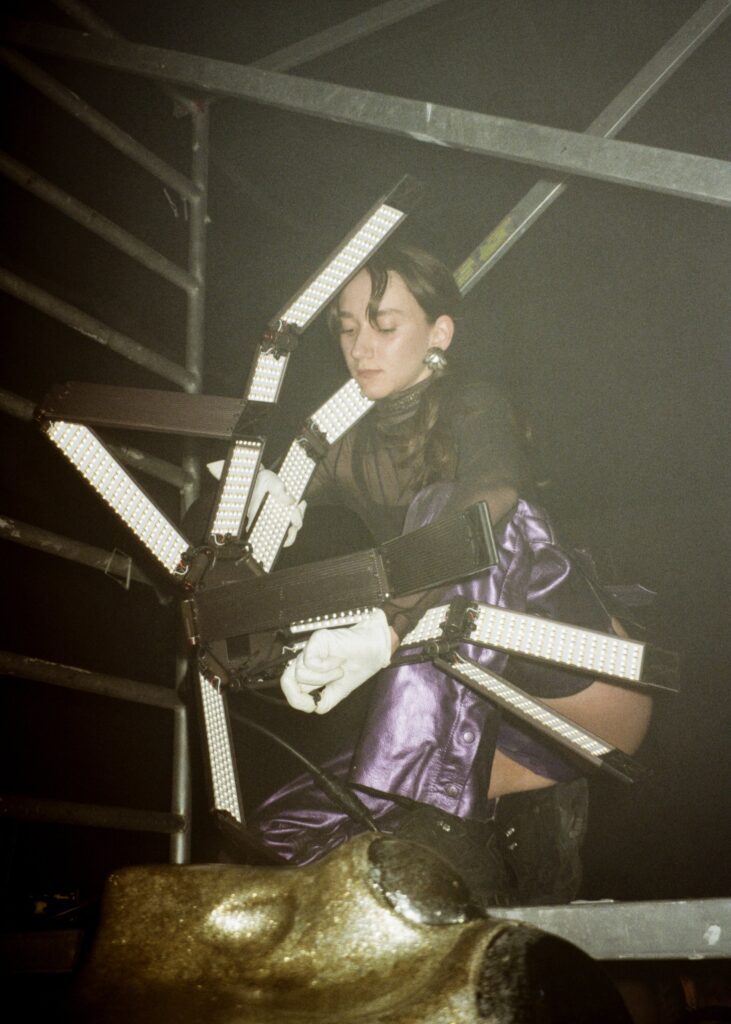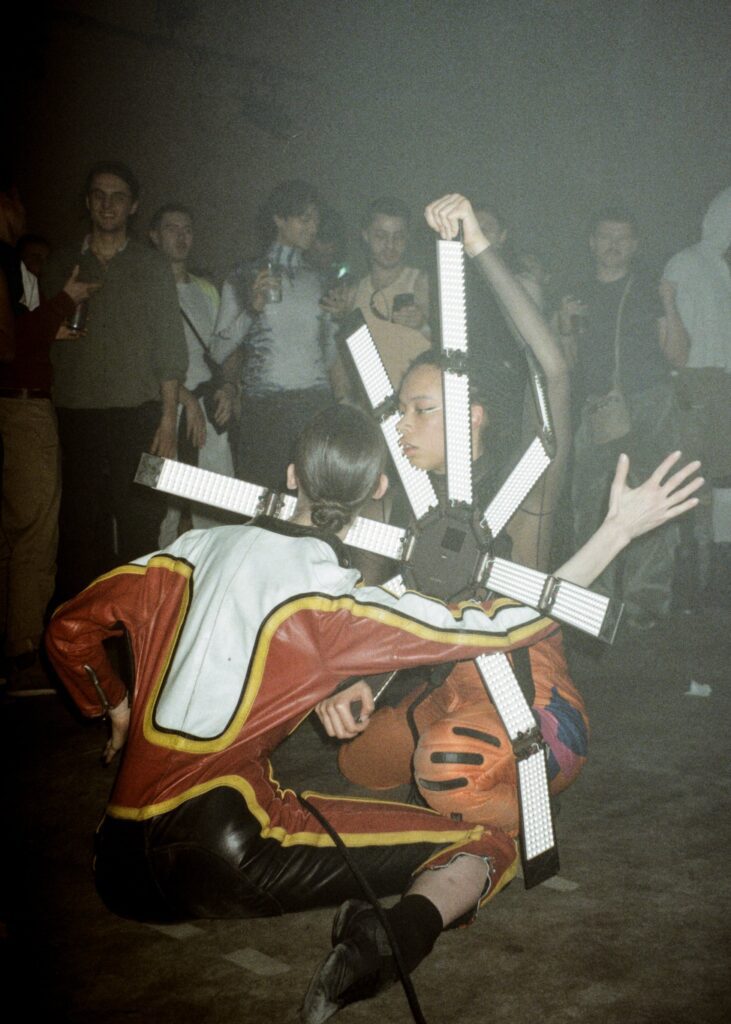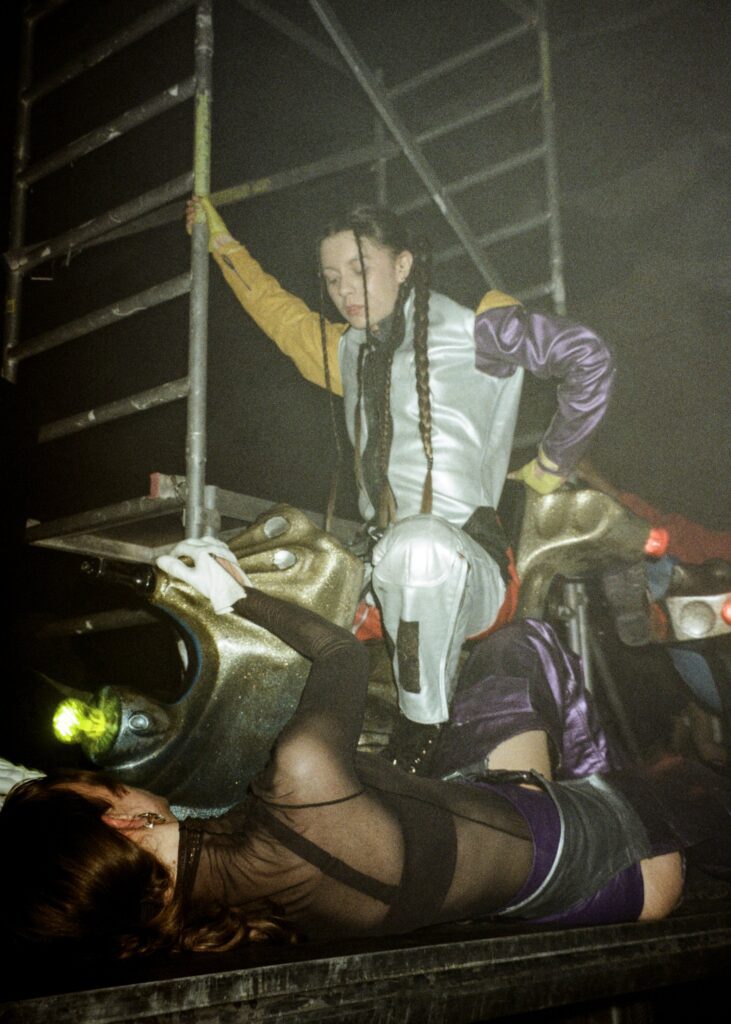This essay is the first of a series by Olivia Turner Saul called ‘Expanding Bodies: Mapping the Intra-action of Body, Technology, and Ecology in Contemporary Performance Art’, which critically explores how selected contemporary performance artists challenge and redefine traditional conceptions of performance art and corporeality. By incorporating both organic and non-organic entities and employing innovative analog and digital technologies, these artists expand the boundaries of the art form and our understanding of the material body.
The notion of presence, non-reproducibility, and the agency of human living bodies have been an intrinsic definitional value in understanding performance art. It has been rudimentary in the definition of performance art following performance scholar Peggy Phelan’s influential work Unmarked: The Politics of Performance (1993), in which she states the following:
“Performance cannot be saved, recorded, documented, or otherwise participate in the circulation of representations of representations: once it does so, it becomes something other than performance […] It can be performed again, but this repetition itself marks it as ‘different’. The document of a performance then is only a spur to memory, an encouragement of memory to become present […] Performance implicates the real through the presence of living bodies. […]”1
However, within the current landscape of contemporary performance art, we are forced to question and challenge traditional understandings of the art form. Artists are redefining and recalibrating not only our conventional understanding of presence but also our presumptions of the human body as the sole performer by implicating organic and non-organic bodies in their performances. In this essay series titled Expanding Bodies: Mapping the Intra-action of Body, Technology, and Ecology in Contemporary Performance Art, I will explore, analyze, and discuss how contemporary performance artists expand our understanding of the body while rethinking the foundations of the art form through their innovative use of analog and digital technologies. My examination will strive to map the convergence of body, technology, and, in some instances, ecology, with the aim of fostering understanding and awareness of this exciting development.

London-based Romanian artist Catinca Malaimare (b. 1996) works within the thematic framework with an intentionality and semantic awareness that I have admired since I first encountered her solo performance installation Gamma and Omega Hold Hands at the Zabludowicz Collection in London in 2023. In her interdisciplinary practice, Malaimare depicts the human’s intimate and almost romantic relationship with digital and mechanical technologies by combining sculptural material, text, technology, and the live body. In her performance and video works, anthropomorphic machines, bodies, screens, and reflective objects ritualistically investigate notions of corporeality, emotions, and desires in conjunction with technological mediation. More recently, Malaimare’s practice has expanded through her use of delegated performance and low-fi technologies to investigate the synthesis between organic and inorganic matter further.2 I had the privilege of speaking with Malaimare on Facetime on one of the first days of spring while she was preparing for her upcoming performance exhibition in Berlin. Throughout this essay, brief excerpts from our conversation will emerge, offering glimpses into Malaimare’s reflections on her practice and the overarching themes.
Olivia Turner Saul [OTS]: How would you introduce your artistic practice and describe your role within it? Could you elaborate on the key themes and materials you engage within your work?
Catinca Malaimare [CM]: “I think my practice is mostly self-referential, reflecting my own desires and hidden thoughts. It’s almost like performing intrusive thoughts, especially through movements that might be perceived as sexualized or even perverted. These performances often involve humans interacting with technological objects, sharing body and space. Now that I am not performing the work myself, I see it even more clearly as self-referential. When I was part of the performance, it was too burdensome to simultaneously express my desires and be the face of the work. There is a formula that I subconsciously go through when I create a performance, and it has a lot to do with the agents who will perform the work. The human and non-human formula appears inexhaustible thanks to an excess of technology and multiple retired generations of technologies”.
French philosopher Gilbert Simondon (1924-1989), renowned for his works on technology and individuation, argued that by continuously substantializing technology as mere objects, we fail to grasp their true essence and potential. Instead, Simondon introduces the concept of ‘technicity’, proposing a new ontology that redefines the role and existence of technology. In this view, technicity is perceived as a mediator, not in a representational manner but in its function, that brings other beings and virtual possibilities into existence. Technicity acts as a world-builder through its activity, emerging from and sustained by reciprocal relationships and interactions with other entities. These entities influence one another by exerting forces, thus creating new potentials.3 Drawing from a Simondonian understanding, technological entities in Malaimare’s practice can be perceived as co-creators alongside the human body. The technologies are endowed with an agency and ontological force in which the conventional hierarchy and perception of non-organic bodies as secondary are dismantled.
In March 2024, Malaimare showed her performance, with the working title, Immersive Performance at the London nightclub Club Are, hosting immersive multidisciplinary club nights, fusing fine arts, music, and fashion. In the middle of the dance floor, five performers, including Malaimare, step onto the bare scaffolding, enveloped by a crowd of sweaty, dancing clubbers. The air is thick with fog from the smoke machine, and a rhythmic thump pulsates in the background. The performers gradually begin their choreography as the beat echoes through the space. Dressed in repurposed vintage leather biker jackets and pants, in reds, greens, and metallics, the performers each begin an intimate exchange of movements and interactions with relics of a technological past. Set in two parts, the performance combines Malaimare’s Royal Academy graduation piece Emergency Ex (2022) and a new work from 2024. The performance begins with two performers embracing a theriomorphic LED light installation, its extended limbs resembling those of a spider while its lights flicker in synchronization with its own rhythm. The human performers meticulously explore the spider, brushing their faces against the structure and tenderly dancing with it while responding to each other’s movements.

CM: “So, that was one part of the performance where the spider—this kind of anthropomorphic object—was a dancer and an object of desire. It was also like a ritual, with the two dancers showcasing this electric, technological newborn to the world. It explored the idea of what a newborn would look like or behave like if it were a technological body rather than a human.”
Two of the other performers climb onto malfunctioning coin-operated kiddie rides in the shape of a spaceship. Slowly maneuvering around the structures sensually and caressing them intimately, they are prompted by cues and gestures facilitated by their intra-action with the spaceships.4 The kiddie-rides serve as mediators of movement and become corporeal performers actively participating in the performance. Physicist and feminist theorist Karen Barad introduces the concept of intra-action, which captures the intertwined agency and entanglement of organic and non-organic performers in Malaimare’s Immersive Performance. Here, it is unclear what influences what, as agency emerges not from distinguishable entities but from an interconnected whole involving music, performers, kiddie rides, lights, movements of performers, clubbers, and DJs, all forming what Barad describes as the phenomenon. The process of intra-action determines the boundaries and characteristics of the components within phenomena, thereby giving embodied concepts their meaning. According to Barad, boundaries are dynamic rather than fixed, continually fluctuating. She suggests that the fundamental ‘ontological units’ are not static ‘things’ but rather phenomena – dynamic, topological reconfigurations, entanglements, relationalities, and (re)articulations.5

OTS: How is your perception of agency within your practice?
CM: “I try to be fair with all the performers in my work, whether they are human or non-human. However, when you involve technology with humans, it’s very hard to get rid of the belief that humans feel fear and are threatened by technology. It’s kind of funny because we constantly push the technology we create to levels of agency that feel very threatening to us as a species. Then, we pull the plug when it gets too close to becoming an agent”.
The music in the performance is mixed live by DJs Kasra V and Eoin, and there is an oscillating dialogue between them and the performers in which the DJs immediately respond to the performers’ actions, the beat and rhythm gradually picking up pace. The boundary between the dance floor and the art performance dissolves and shifts in sync with the music’s speed and intensity. The almost trance-like state of the performers gives ritualistic connotations, their movements melting into one another, the scaffolding of their altar, and the kiddie rides and spiders light their idols. Ritual is embedded in Malaimare’s thematic approach in her practice, a methodology in which she draws parallels between a human body’s choreography and a computer’s coding.
CM: “Ritual is a performance form that both human and technological entities share. Perhaps technology is so intrinsic because it is created by our conscious and subconscious minds. Ritual is a coded narration of something, a codified form of information, and a learning tool. Performers are also reproducing a code or choreography, and in that strict movement reproduction and translation, they edge closer to a computer that performs well”.
In anthropologist Tok Thompson’s examination and repositioning of the human within a folklore framework. He notes the pivotal role technology has become in some belief systems, transforming our understanding of the cosmos and humanity, in which advances in science have blurred the lines of what constitutes the category of human, and as a result, “people are redefining themselves in ways that are often strikingly posthuman.”6 In this coming June, Malaimare will investigate the posthuman folkloric framework further. The Berlin gallery Eigen + Art Lab will host Malaimare’s solo exhibition and performance Jinx, Nevesta!, a sequel or extension of Immersive Performance. Four brides will walk down the aisle and be wedded to technological objects that reminisce a nostalgic past. The two kiddie-ride spaceship performers from the previous performance will be reunited with two duplicates. Their shimmery metallic bodies stand as sentimental relics of a childhood memory, the brides mounting and exploring them through movement and touch. The organic bodies of the brides and the non-organic bodies of the spaceship amalgamate and become an extension of one another.
By considering Italian theorist Rosi Braidotti’s reading of the ideas of French philosopher Felix Guattari, one can find similarities between Malaimare’s fusion of bodies and Guatarri’s concept of machinic autopoiesis linking organic matter with technological artifacts. In this instance, machines are redefined as intelligent and generative entities with their own timelines and capacities for development. Emphasizing self-organization, this idea frames the posthuman subject as a synthesis of human and machine, forming new, interconnected modes of existence. These machines aren’t mere metaphors; they process and connect forces, fostering mutual interdependence between species. Thus, technology serves as a site for post-anthropocentric becoming beyond human-centered perspectives and a space for constructing multiple worlds and futures.7 Romanian sound artist Chlorys blasts a medley of techno beats and Romanian folk melodies out of a 90s Panasonic SA-AK320 Stereo, creating a sound tapestry that references Malaimare’s own heritage. It simultaneously demonstrates a fascination with and unease about technology melded with religious themes, a syncretism of pagan beliefs, and Catholic rituals.

OTS: I find it interesting how you incorporate your own Romanian heritage and rituals into your hyper-technological praxis. Could you share your thoughts on how folktales inspire you and why rituals play such a big part in this?
CM: “Well, folk tales have always been a part of my upbringing, almost woven into the fabric of my childhood and education, with their poetic narratives lingering in the background. While they weren’t a primary focus for me initially, as I delve deeper into crafting performances that explore romantic interactions between humans and non-humans, delving into folk culture, particularly Romanian folk, felt like a natural progression. It’s a cultural landscape I can easily access, and it resonates with me due to its roots. What intrigues me is the juxtaposition of folk, deeply rooted in the earth, with technology, which often feels disconnected and controlled yet seemingly lawless. This duality sparked my interest, as it presents fewer visual constraints and offers intricate entanglements. The concept of celestial entities, like the Sun and Moon [Romanian folk myth], engaging in a choreographed ‘wedding’ mirrors human rituals of engagement and marriage, albeit on a grander scale. This alignment of cosmic and human ceremonies fascinates me, illustrating different scales of existence – from the celestial to the animal to the human level. Although I wrestle with the notion of placing humans at the center, my performances inherently prioritize human experiences. Growing up alongside the rapid evolution of technology, it’s challenging to shake off the belief that humans are central. Our generation witnessed technology’s exponential growth, shaping subsequent generations faster than our own development”.
The most recent performance Jinx, Nevesta!’s thematic union of the astral spaceships and terrestrial brides refers to the Romanian folkloric myth of the Sun and the Moon Marriage, in which the Sun wishes to marry his sister, an earth-bound mortal fairy. The fairy refuses to marry her brother and, to dissuade him, sets him impossible tasks: building copper, silver, and golden bridges over the sky. He completes these easily, but to avoid the marriage, she jumps into the sea from the golden bridge, metamorphosing into a silvery fish. God takes pity on her and raises her to the sky as the Moon, forever separated from her brother, the Sun.8 Celestial bodies like the Sun and Moon and the spaceships and technological bodies depicted in Malaimare’s performance symbolize the extraterrestrial. In contrast, figures such as fairies in the folktale and the brides in the performance are associated with earthly realms. The interaction between folk culture and technology highlights a shift in perspective, where cultural traditions and future technological advancements cannot be perceived as separate entities. Instead, they are interconnected and serve as parts of a cohesive narrative that bridges our understanding of the past with our vision of the future and their symbiotic relationship.9

Malaimare’s work embodies the convergence of organic bodies and technology, in which she presents us with a synergistic interplay between human desires and technological mediation. Her performances emphasize the intricate relationships between human and non-human performers, stressing the fluidity and reciprocity of agency and the interconnectedness of all entities involved. As we navigate the evolving landscape of performance art, we must acknowledge the multiplicity of perspectives and the innovative ways in which artists like Malaimare are redefining the art form. Their work expands our understanding of performance and encourages us to envision new possibilities for embodiment, where the boundaries between the human and technological body are reconceived.
Catinca Malaimare’s show Jinx, Nevesta! is on view at Eigen + Art Lab in Berlin from Friday, June 7th, with a ceremonial performance at 7:30 PM.
Catinca Malaimare is a Romanian-born London-based artist. She received her MA at the Royal Academy School, UK, and her BFA at the University for Creative Arts, UK. Recent solo and museum exhibitions include Metamour, Final Hot Desert, London, UK; Astropriest, Brooke Bennington Gallery, London, UK; Gamma and Omega hold hands, Zabludowicz Collection, London, UK; cross-border, Very Contemporary Performance Festival, curated by Brenda Guesnet (IKOB Museum of Contemporary Art), Kunsthaus NRW, Aachen, DE; Best Boy Electric, 20th Biennial of Art Pančevo, refinery monastery, Pančevo, SRB; Emergency Ex, Catinca Tabacaru Gallery, Bucharest, RO; among others.
- Peggy Phelan, Unmarked: The Politics of Performance (London: Routledge, 1993). 146-148 ↩︎
- Olivia Turner Saul, “Digital Corporeality in the Symbiocene: Expanding the Ontology and Methodology of Performance Art” (London, The Courtauld Institute of Art, 2024). ↩︎
- Aud Sissel Hoel and Iris Van Der Tuin, “The Ontological Force of Technicity: Reading Cassirer and Simondon Diffractively,” Philosophy & Technology 26, no. 2 (June 2013): 187–202 ↩︎
- Barad defines intra-activity as the causal relationship between bodily production and the phenomena produced. She proposes that intra-actions take place within matter, endowing it with agency. This perspective is foundational to my understanding and approach regarding posthuman and post-phenomenological performance, as agency is not intrinsic to matter but rather a continuous and iterative process. ↩︎
- Barad. 818 ↩︎
- Tok Freeland Thompson, Posthuman Folklore (Jackson: University press f Mississippi, 2019). ↩︎
- Rosi Braidotti, The Posthuman (Cambridge, UK: Polity Press, 2013). 93-95 ↩︎
- Ana Radu Chelariu, Romanian Folklore, and Its Archaic Heritage: A Cultural and Linguistic Comparative Study (Cham, Switzerland: Palgrave Macmillan, 2023). 109-119 ↩︎
- Thompson, Posthuman Folklore. 24 ↩︎
